Photo Corners headlinesarchivemikepasini.com
![]()
A S C R A P B O O K O F S O L U T I O N S F O R T H E P H O T O G R A P H E R
![]()
Enhancing the enjoyment of taking pictures with news that matters, features that entertain and images that delight. Published frequently.
Lightroom Mobile -- An Ecosystem For Photography




23 April 2014
When Lightroom Product Manager Tom Hogarty briefed us on Lightroom mobile a few weeks ago, he suggested photography was undergoing a tectonic shift. He was referring to the explosion in snapshots coming from the mobile device crowd.
But there's another way to look at the tectonic shift.
One tectonic plate would be the advanced photographer who now considers Lightroom as integral to their photography as a camera. The other tectonic plate would be the snapshooter with a mobile device. And they are often the same person.
This photographer's images, though, live on two different continents. They're either trapped on those mobile devices or locked away in Lightroom on the desktop.
There's a need, Hogarty said, to organize, edit and share images from any device, an argument you'll recall from the Revel gang.
Revel addresses that need for primarily JPEG shooters (but not just) who don't want to maintain a catalog of their images. But what about Raw shooters? What about photographers who use dSLRs and mirrorless cameras and spend hours in a chair at their desktop tweaking their images for prints, books and the Web?
If Lightroom ran on a tablet like Revel, it could host all your images without trapping them on a desktop system.
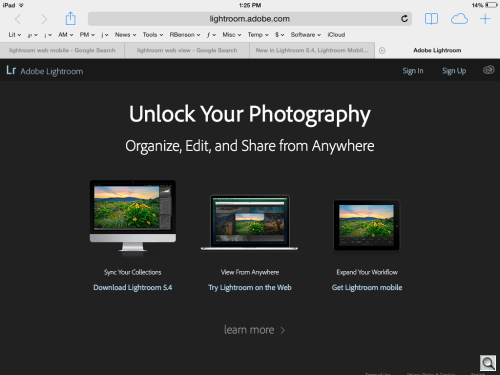
Lightroom. There are three facets to the new ecosystem: desktop Lightroom 5.4, Lightroom Web View and Lightroom mobile.
So Adobe conceived Lightroom mobile, the essentials of Lightroom packed into a tablet operating system to seamlessly access your image collection for just those tasks.
And version 1.0, released this month, was made available to the photographic community at no addition charge to Creative Cloud subscribers (contrary to rumors last year that it would sell for $99).
We've been working with it -- along with a new version of Lightroom and the new Lightroom Web View service -- for a couple of weeks since the announcement. These three facets of Lightroom comprise a new ecosystem for photography that promises to take the natural disaster out of the tectonic shift. Here's our review.
SYSTEM REQUIREMENTS | Back to Contents
To use Lightroom mobile, you must have:
- Lightroom 5 running on your desktop computer
- An iPad 2 or later running iOS 7 (versions for the iPhone and Android devices are in development)
- A Creative Cloud subscription, of which the $9.99/month Photoshop Photography Program is the least expensive
If you don't have a subscription, you can take advantage of Adobe's 30-day trial program. Lightroom perpetual licensees automatically get a 30-day trial to Lightroom mobile as well.
Storage on the Adobe server is unlimited (which has interesting implications) and does not count against your Creative Cloud allotment.
ACCESSING MOBILE | Back to Contents
There are five steps to setting up a Lightroom mobile workflow. In a nutshell:
- Update Lightroom 5 to v5.4.
- Download the free Adobe Lightroom app (it is not called Lightroom mobile in the App Store) for the iPad 2 and up.
- Log into your Creative Cloud account from Lightroom 5.4.
- Sync albums from either desktop Lightroom or Lightroom mobile.
- Log into http://lightroom.adobe.com to access and view your synced albums from a Web browser.
THE SYNC | Back to Contents
Key to this arrangement is the sync. There are two tricks to it.
You won't be syncing your entire Catalog. You don't want to. You have how many images (over 52,000 here) in your Lightroom Catalog?
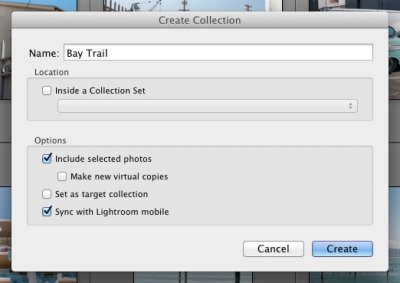
Create a Collection. You can name it, automatically populate it with the selected photos and sync it.
Instead, the first trick is to sync a Collection (or two) rather than your Catalog. Here we've done it in desktop Lightroom because that's where you Catalog is. But you can create a Collection in Lightroom mobile, too (as we'll show you).
A Collection is simply "a group of any photos you choose to put in a group," as Adobe puts it, a subset of your Catalog. You can set them up however you like, by date, location or event typically.
In this version of the game, you can't sync Smart Collections, which are virtual groups of images based on criteria you define for the set. An example might be any image taken in May 2012. Lightroom checks the Exif data for the capture date of any image in your Catalog and will list the image in the May 2012 Collection if it was taken in May 2012.
So it's Collections.
The second trick is that Lightroom syncs Smart Previews rather than full size Raw files or JPEGs.
A Smart Preview is a lossy DNG Raw file that is restricted to 2560 pixels on the long side. That's typically a lot smaller than your Raw+JPEG image, or even just the JPEG capture from a dSLR or mirrorless camera.
But it's also a lot more information than just a JPEG contains. You have more tonal and color data to work with (more than you can see) as well as sufficient resolution to enlarge the image on your iPad.
Smart Previews were new to Lightroom 5, which is why Lightroom 4 isn't playing this round. You can force Lightroom to create them for you when you import images but they swell the size of your Catalog. If you need to see your whole Catalog on the road, that makes sense, but otherwise, they just sit there taking up space.
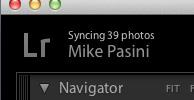
Syncing. When you sync a Collection, you'll see the sync progress updated by your ID.
If you haven't enabled Smart Previews for your Catalog, Lightroom 5 will generate them on the fly for any Collection you sync. It's the Smart Preview that is sent to the Adobe server to sync with your iPad. And it's the Smart Preview that Lightroom Web View uses to show off your work.
This, though, creates a little problem.
It works fine if you upload your Raw files to desktop Lightroom, create a Collection and sync them so desktop Lightroom makes Smart Previews and uploads them to the server. But if you're in the field with nothing but your tablet, how are you going to get Raw files to the server?
Adobe is wondering about that too. As Hogarty put it:
We've utilized a Smart Preview solution on the desktop to expedite access to original files on mobile devices but that becomes more difficult going in the other direction due to processing requirements and the fact that customers would expect the original to eventually arrive on their desktop. (And that transfer to the desktop should occur without a kludgey, manual copy and link-to-original workflow from the CF or SD card.) We'll need to address all three of these areas before we can have a suitable field triage workflow. We can tackle the bandwidth requirement with intelligent, downstream use of P2P speer-to-peer] connections but the first two issues will still remain a challenge.
So Lightroom mobile v1.0 can't sync images that you've shot on location to your desktop from the field. You'll still need to bring along your laptop.
You can sync images on your Camera Roll and images you acquire with the iPad camera. They're just JPEGs, after all.
And edits to the images you alter on the iPad are synced with the desktop, too. Or we wouldn't we using the word "sync" to describe this process.
More than the edit alone has to be sent back, though, because Lightroom Web View requires the images as well. But the Smart Preview only has to go back to the Adobe server, while the smaller changes can quickly continue to desktop Lightroom.

Collections List. The first column checkbox enables sync with Bay Trail, Opening Day and San Francisco Collections synced here.
A synced Collection will update itself automatically on anything running either desktop Lightroom or Lightroom mobile. But the beauty of syncing is that your desktop Catalog gets seamlessly updated with any changes you make in Lightroom mobile. That's a big deal.
How To Sync
Now that you know how the sync game is played, how do you get a Collection to sync?
Just click the sync icon to the left of the Collections name in the Collections list. Simple. You'll see a progress indicator in the top left. Synced images will have a small sync icon on them in thumbnail view.
LIGHTROOM WEB VIEW | Back to Contents
Lightroom Web View is separate from both desktop Lightroom and Lightroom mobile. It isn't an application so much as a service you access from your Web browser (using the link that starts this paragraph).
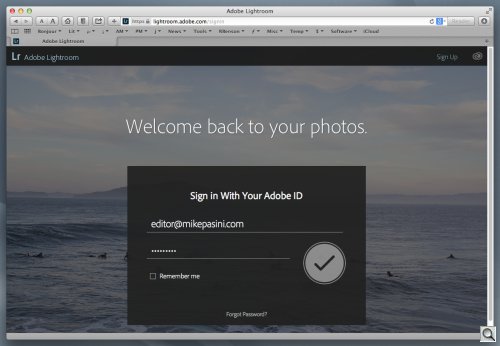
Sign In. Use your Adobe ID.
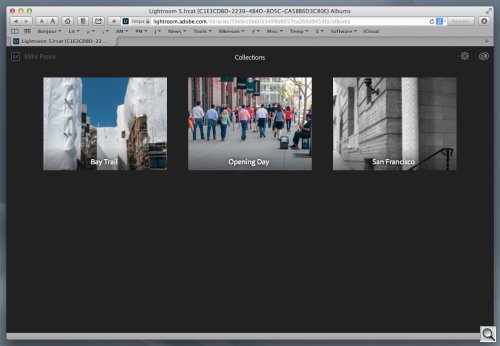
Collections. Our three synced collections.
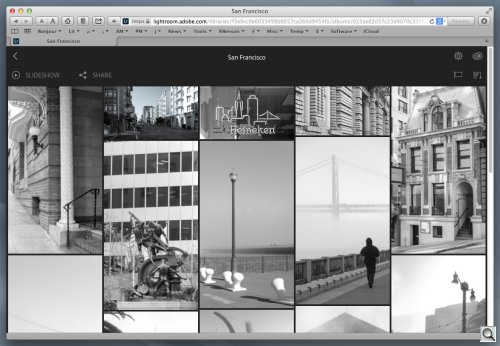
Light Table View. Our San Francisco collection.
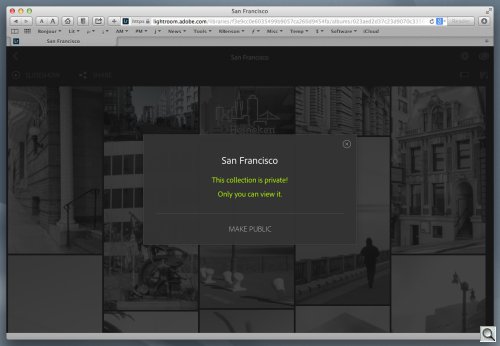
Sharing. Make it public so you can share it.
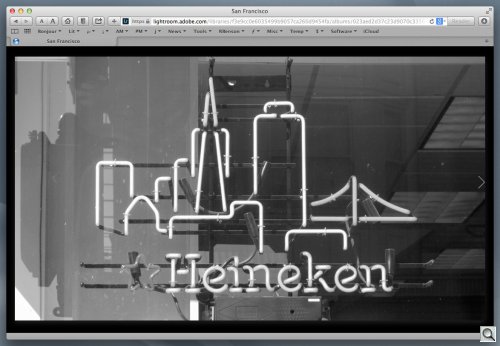
Slide Show View. Full screen with cross dissolve transition.
And because Lightroom Web View hosts the Smart Previews for those images, you can run a slide show of any of the synced Collections. There's only a cross dissolve transition available, but that just happens to be the transition we prefer.
Access to your Collections is private by default but you can make those Collections public, too. When you do, you can share the URL for that Collection. You can also share images to various social media platforms. And you can revert to private at any time.
Because you access Lightroom Web View from a browser, it is equally accessible from your mobile device and your desktop system. So you can share a Web-based slide show from your mobile device after editing the images in Lightroom mobile.
Lightroom Web View thus provides both private and public viewing of your synced (and Adobe hosted) Collections from any browser. Lightroom has always been able to build Web layouts and slide shows but you had to host them yourself somewhere. So this adds a significant new sharing option to Lightroom.
And with unlimited storage on the Adobe server, this looks a lot better than Revel's similar URL sharing option.
We've asked Adobe how long a publicly-shared URL would be active and they're looking into it. Storage may be "unlimited" but it isn't clear how permanent public slide show links are. We suspect they disappear when you disable sync. Meanwhile we've made our San Francisco Collection public to see how long it stays up.
THE MOBILE ENVIRONMENT | Back to Contents
Lightroom mobile is a work in progress. Standing on the shoulders of both desktop Lightroom and Revel, it's off to a pretty good start.
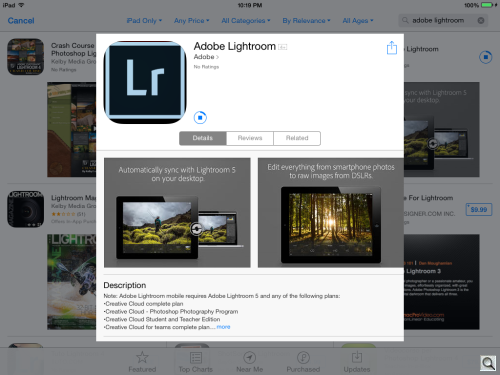
The App. It's actually called Adobe Lightroom on the App Store.
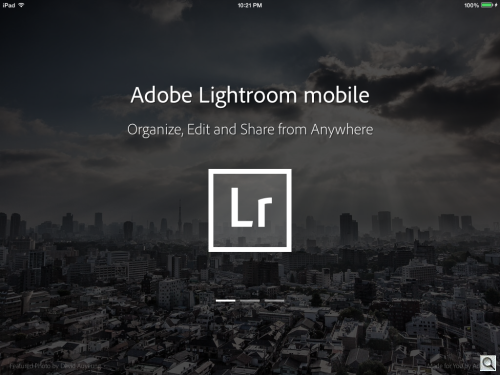
The App Launched. Three mysterious bars. But you only see this sign-on screen once.
But it's important to chalk the lines on the field before starting to play. Let's look at the workflow situation.
Workflow
What you can't do, as we said above, is sync Raw images from the field through Lightroom mobile. But you can sync JPEGs on your Camera Roll. Julienne Kost's video shows how to do it automatically.
This means high end work is going to start with desktop Lightroom and migrate to Lightroom mobile while snapshots can start in either place.
But we've found you would be wise to end your work on any set of images in desktop Lightroom. It's the only color-managed workspace and that makes a very big difference, particularly since desktop monitors do not have the tonal and color limitations of mobile devices.
One other workflow issue worth noting is that until the app makes it to the iPhone and Android smartphones (which the team is working on now), getting the snapshooter's tectonic output into Lightroom mobile is not very efficient. But when it does arrive, that problem will vanish. You'll be able to automatically add the images you take on the device to a Collection just as you can now on the iPad.
Connections
We stuck to a WiFi-only connection where we weren't being metered. You can set a preference to enable Lightroom mobile's sync only for WiFi, in fact.
A cellular network connection is probably not a great idea. As Adobe's Richard Curtis notes in his Lightroom Deep Dive, "I have also managed to sync a small collection of images over 3G was well (but don't recommend this, as it may cause an increase of data usage with your mobile provider)."
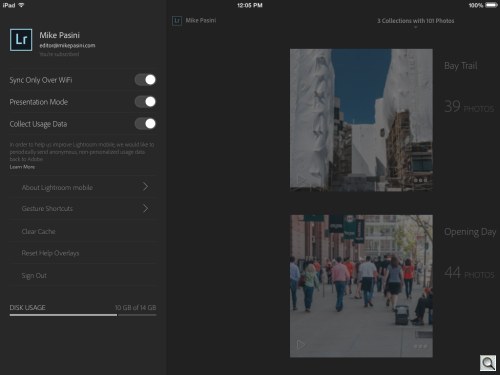
Settings. Tap on your name to see Lightroom mobile's options, including Sync Only Over WiFi.
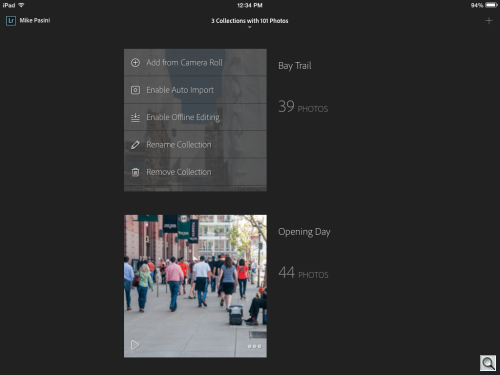
Collection Options. Tap the lower right corner of a Collection thumbnail to see the options.
But you can also Enable Offline Editing (and display) to use Lightroom mobile when you aren't connected. You access this from the Collections display by tapping the three dots in the bottom right corner of the thumbnail as seen in the Collection Options screen shot just above.
That option uses more space on your mobile device than Lightroom's usual cache requires, of course. But you can squeeze over 2,000 images in about 3-GB of storage on the iPad, Curtis says.
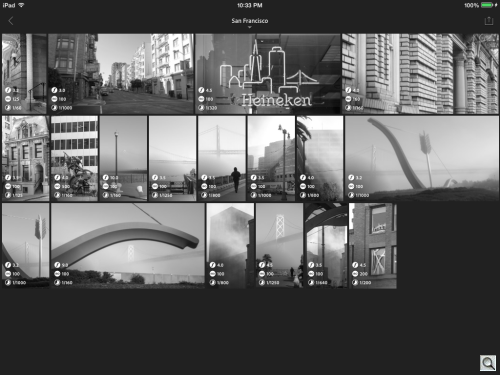
Collection View. Our San Francisco Collection on the iPad displaying f-stop, ISO and shutter speed.
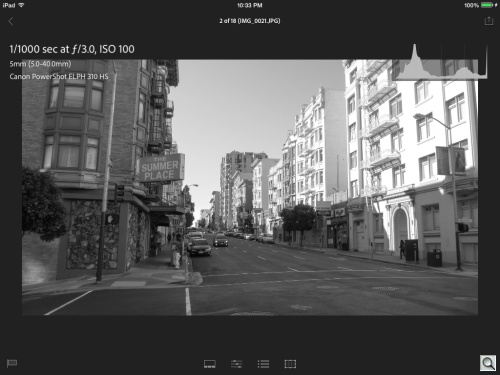
Image View. Four buttons at the bottom for Filmstrip, Edit, Presets and Crop. Note the histogram in the top right.
When you make a WiFi connection again, Lightroom mobile will sync any changes you made during offline editing.
Interface
On a mobile device, you live in the land of taps and swipes not clicks and dragging. It's different.
Built into Lightroom mobile is gesture help. You can disable it and re-enable it, which we found, uh, handy. Just pop into the Help screen by tapping the Lightroom icon in the top left. There is nothing intuitive about some of the gestures, so you have to be told what they are.
Here's a few:
- A two-finger tap in Collections view toggles the Info displays.
- Swipe up to Pick and down to Reject in Loupe view.
- A three-finger tap in Loupe view toggles Before/After views.
- Reset an adjustment with a two-finger tap on either the tile or the slider.
- A two-finger swipe on a slider reveals the clipping mask.
- A two-finger tap when cropping toggles the gridlines.
- A double tap on the frame in cropping resets the crop.
Tasks
Lightroom mobile takes "a laid back approach," Curtis explains. It's designed to let you do a little organizing, editing and sharing of your images away from your computer.
So organizing, editing and sharing are not fully implemented. You don't have all the options of desktop Lightroom in Lightroom mobile.
But you have plenty to play with. Let's take a look at what you can do.
ORGANIZING | Back to Contents
The most important organizing task you can perform in Lightroom mobile is flagging images. As you swipe through a Collection, you simply swipe up to Pick or down to Reject the current image.
There is, however, a minimum swipe you must perform to actually set either option, which we found a bit annoying. The gesture itself should suffice (some minimum travel is required) and if you look closely at the screen you'll see why. The Pick or Reject flag has to scroll into the small circular flag window before it takes effect.
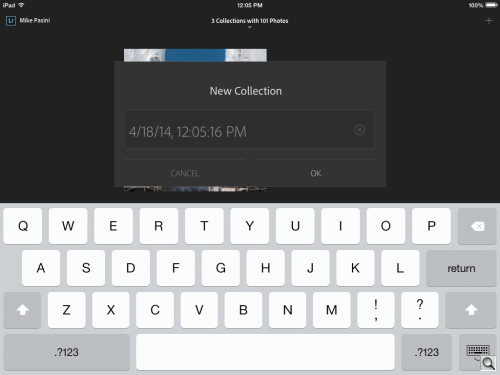
Create a New Collection. To add photos from your Camera Roll and the Camera app you create a new collection on the iPad.
You can also set filters on a Collection by tapping its title. This is primarily helpful as a viewing aide rather than an organizing aid, at least the way we work. That's because there aren't many filtering options: All, Unflagged, Picked or Rejected.
Coming soon to a screen near you, we're told, is star ratings. Picks are not enough.
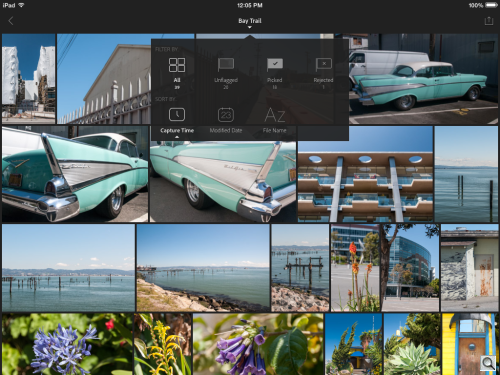
Filters. All, Unflagged, Picked, Rejected by Capture Time, Modified Date or File Name. Here we're showing all the images in the Collection.
You can, however, also sort the Collection by Capture Time, Modified Date or File Name.
Missing in this version of Lightroom mobile is keywording. That's like getting out of homework to us, but if you're in the habit of keywording when ingesting, it's another reason not to ingest on your mobile device.
So these limitations may oblige you to juggle your workflow a bit. Do your picks on the tablet but wait for star ratings when you get back to the desktop. But they represent more of a headstart than a nuisance, so we have to applaud them.
EDITING | Back to Contents
First, outright prolonged applause for providing Raw data to edit on a mobile platform. It's a lot of fun to work on these images because Raw data contains more tones and colors than you can see at one time. You have to fiddle around to tweak the image.
So it surprised us that Lightroom mobile does not let you create a virtual copy of an image. And even if you create a virtual copy in desktop Lightroom, it won't sync to Lightroom mobile.
Changes are automatically synced, although you can force a sync at any time using the Cloud icon in the top left corner. We never found that necessary. We must have been influenced by the "laid back" nature of the app.
To get back to the Collections display, tap the back arrow in the top left. To Share, tap the Share icon in the top right.
Basic Development
Edits are, Hogarty told us, restricted to the Basic panel in the Develop module of desktop Lightroom.
Represented by a tile running along the bottom of the screen, those include White Balance, Temperature, Tint, Auto Tone, Exposure, Contrast, Highlights, Shadows, Whites, Blacks, Clarity, Vibrance, Saturation, Previous and Reset.
Tap one of those tiles and a slider appears above the tiles so you can change the value, which is also reflected in the tile itself. You can't directly edit the value in the tile itself, but that would require a keyboard, which would obscure the display.
Presets
You can also apply some standard (but not custom) Presets. Like the image edits, they are organized in tiles but when you click on a tile, a popup shows you what's available with a small thumbnail preview using your image. Nice touch.
Tiles include B&W, B&W Filter, B&W Toned, Color, Effect, General, Preview and Reset.
Crop
The Crop tool also displays a set of tiles covering the usual options. Those includes the Aspect ratios (1x1, 5x4, 11x8.5, 7x5, 3x2, 4x3 and 16x9) and a Centered toggle.
When our Collection was still being synced we thought we would edit a few images, but nothing happened when we clicked on the Crop tool. This confused us. Why was Lightroom mobile not responding?
We got a clue when we tapped into Filmstrip mode and didn't see the histogram for a while either. During sync, it took several seconds for the image to become available.
That wasn't the case once our Collection had synced. Operations were responsive.
Filmstrip
The first option is the filmstrip display which lets you navigate the collection, jumping from one full screen image to another without visiting them in sequence.
Like the Editing and Presets options, it lets you see the image full screen and set a Pick or Reject flag.
It also displays a histogram, which we found helpful for signaling when the Smart Preview had been loaded, as we just pointed out.
It's a nice way to go through your Collection at leisure, marking the best images.
Notes
With 2560 pixels on the long side, Smart Previews provide some enlargement even on Retina iPads (which have a resolution of 2048x1536, four times the number of pixels on an iPad 2).
We really don't much like the screen-wide slider. We understand it gives you refined adjustments but we find it less helpful than the graduated sliders in desktop Lightroom. Which way darkens, which lightens? We miss that visual clue.
We also don't much like the layout of the editing controls along the bottom of the screen in tiles. It isn't an efficient use of space. A label and a small scrubbing slider (that magically enlarges when engaged) would have delighted us.
We've mentioned the color management issue. Our images looked great in Lightroom mobile, better than we recall seeing them in other apps on the iPad. That isn't the issue.
It's that when we returned to desktop Lightroom we made some significant tweaks to the edits we had made in Lightroom mobile. We should have been able to see the same issues in Lightroom mobile that desktop Lightroom displayed. But we didn't. So we just didn't trust it with final edits.
That's not an Adobe issue. It's a mobile platform issue. There just isn't any system-wide color control.
We can just imagine why Lens Corrections are not part of Lightroom mobile. And if adding them would have meant dropping iPad 2 support, we're glad they're not there.
Well, "glad" is too strong a word. We've surprised ourselves with how often we use Lens Corrections. So we defer that tweak to our return trip to desktop Lightroom along with our final tonal and color corrections.
And tell ourselves to think of the headstart we got, not what we have left to do.
SHARING | Back to Contents
Sharing options, accessed by the usual iOS sharing icon in the top left corner of the display, include Share, Copy To, Move To, Remove and Play From Here. Except for Remove, they all have options.
The Share options depend on your configuration. That may include AirDrop, Message, Mail, Twitter, Facebook, Save Image, Assign to Contact, Copy and Print.
One nice thing about the Sharing interface (particularly for longtime desktop Lightroom sufferers) is the very clear check-mark icon that appears on selected images, which are also ghosted. You won't wonder what's been selected as you sometimes do with desktop Lightroom.
The actual sharing process felt a little awkward. Tap the Share icon and select an option. Then select the images to do it to. We're in the habit of selecting images on the desktop and then performing an action. But it works.
CONCLUSION | Back to Contents
Lightroom intends to be the place you catalog all your photography, both the fancy stuff and the informal snaps. That's a great idea. And this first stab at it is well done, too, despite the limitations of current mobile devices. It provides a seamless workflow between the desktop and mobile versions of Lightroom, keeping your desktop Catalog up to date no matter where you do the work.
Lightroom Mobile -- Deep Dive by Richard Curtis
Unlocking Photography from the Desktop video
Lightroom mobile Tutorials with Julieanne Kost:
• Showcasing & Sharing your photographs
• Setup, Collections and Flags
• Managing Collections and Auto Import
• Cropping, Adjustments and PresetsLightroom mobile blog
Lightroom mobile product video
Get Started with Lightroom mobile
The Field Triage Opportunity by Tom Hogarty
But as Hogarty said in our briefing, the conversation is just beginning. And Adobe has been very open in inviting criticism and suggestions. It isn't an open beta (probably because it requires Adobe server space) but it's close to it. Nobody has to pay anything extra to try it out.
But Lightroom mobile is vulnerable to critics on both the laid-back side (mobile device snapshooters who don't have it on their phones) and the more serious side (event photographers, Raw shooters who can't move their Raw images through their tablets to the Adobe server). That's what you get when you try to be all things to all people.
We'd recommend Revel to the laid-back crew, frankly, at least to practice. That workflow has always been tailored to them.
And we'd send the serious crew to Apple and Google. Mobile devices need a bit more sophistication to handle color managed workflows and Raw files. Of course, moving Raw files over WiFi is never going to be quick.
We have a little work for Adobe to do, too. Refining the interface for editing, supporting virtual copies and cramming a few more tools in there.
Still, it's an impressive first effort and easily the best editing experience we've had on the iPad. But more than that, it presents Lightroom, particularly your Catalog, as an ecosystem for your photography with developing habitats for both your snapshots and more considered work.
It may not be utopia but it's a pretty nice place for your photography to live.